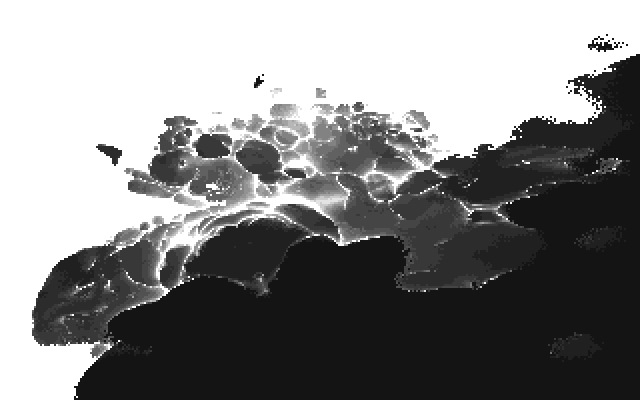A 512 byte DOS intro written by pestis / bC!, submitted to the Lovebyte 2024 512b intro competition.
Source code: https://github.com/vsariola/inkblots
Capture: https://youtu.be/PwvUZLnnzu8
Developed on DOSBox, using dynamic core and max cycles. No idea how much cycles needed.
There is a dosbox.conf file included in the repo; not sure if this the best configuration to watch the intro, but that's what it was developed on.
Massive love to everyone replying my endless questions on the sizecoding #86 channel! I hope you get something back in the form of this intro.
Greets to: superogue, TomCat, gopher, jobe, HellMood, psenough, jeenio, Řrřola, p01, nesbox, okkie, exoticorn, baze, Virgill, byteobserver, ferris, Ped7g, Dresdenboy, aldroid, hannu, wrighter, dave84, havoc, unlord, noby, LJ, PoroCYon, sensenstahl, Blossom, deater, ilmenit, Fready, Jin X, gasman, DevEd, bitl, wbcbz7, teadrinker, Pellicus, GoingDigital, las, mentor, iq, blueberry, fizzer, gargaj, pOWL, silvia, MartiniMoe, NR4!
You need nasm. Then:
nasm inkblots.asm -fbin -o inkblots.com
I made a tiny tracker with a crappy GUI to compose the MIDI music; the tracker is in the (doh) tracker folder. The thing is running on python. I didn't make any way to actually export the song - I just reimplemented the song in DOS once I had something I liked.
cd tracker
poetry install
poetry run main.py
My song is in autosave.json; first thing I did was autosave, because I've lost so much music to my own software crashing ;)
I prototyped the raymarcher in Shadertoy. The fractal was first some kind of kaleidoscopic IFS but then glitched it to something that would be simple enough to implement using the x87 FPU instructions. The critical part was the SDF:
const float ODIV = 3.141592;
const int ITERS = 12;
const float LEVEL = 1.7;
float o = (1.+cos(p.x))/ODIV;
vec3 t = p;
for(int j=0; j<ITERS; j++){
t.x = abs(t.x - round(t.x));
t.xyz = t.yzx;
t.x += t.x;
r += t.x*t.x;
t.x += t.z * o;
t.z -= t.x * o;
}
float dist = sqrt(r)-LEVEL;
The idea was to perform math mostly using one coordinate at a time, and then use coordinate shuffling to do similar math with other coordinates, all while doing foldings, rotations and scalings, and hope we find some kind of fractal there. And we did :) But someone smarter than me can analyze why the hell it still works.
The reasoning behind each line:
t.x - round(t.x)is domain repetition. Onx87,FRNDINTdoes this very cheaply.abs(...)achieves folding of the space. This becomesFABSinstruction.t.xyz = t.yzxshuffles the coordinates. This becomes a pair ofFXCHinstructions.t.x += t.xis same ast.x *= 2.i.e. this is the "scaling" of a kaleiodoscopic IFS.r += t.x*t.xis the weirdest part: instead of computing thelength(t)as is typical for kaleidoscopic IFSs, we make some kind of "cumulative distance squared". I really don't know why it works. Also note that shuffling is done before this, so the first two times this is done, the coordinates have not undergone domain repetition yet. So, we get fractal that is is finite in two directions, but infinite in one direction. I didn't like the fractal being infinite in all directions; it felt too much like flying inside domain repeated SDF.t.x += t.z * o;andt.z -= t.x * o;is a poor, glitchy rotation around y-axis. The amount of rotation depends with thep.x, so the fractal changes.- Finally, since
rist[0].x^2 + t[1].x^2 + ..., the final linefloat dist = sqrt(r)-LEVELis something like the SDF of ball.
Shading is simply based on the number of steps until reaching MINDIST.
The shader version shows just how glitchy the SDF is, but the slow pace, poor resolution and dithering of the DOS version help a lot here.
